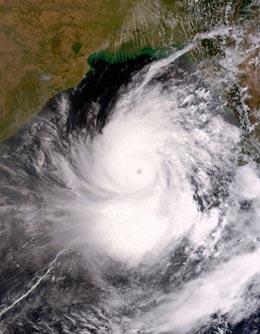 Nature has published a major analysis that supports my recent two–parter. As Nature explains:
Nature has published a major analysis that supports my recent two–parter. As Nature explains:
… scientists have come up with the firmest evidence so far that global warming will significantly increase the intensity of the most extreme storms worldwide.
The maximum wind speeds of the strongest tropical cyclones have increased significantly since 1981, according to research published in Nature this week. And the upward trend, thought to be driven by rising ocean temperatures, is unlikely to stop at any time soon.
The team statistically analysed satellite-derived data of cyclone wind speeds. Although there was hardly any increase in the average number or intensity of all storms, the team found a significant shift in distribution towards stronger storms that wreak the greatest havoc. This meant that, overall, there were more storms with a maximum wind speed exceeding 210 kilometres per hour (category 4 and 5 storms on the Saffir-Simpson scale) …
“It’ll be pretty hard now for anyone to claim that cyclone activity has not increased,” says Judith Curry, an atmospheric researcher at the Georgia Institute of Technology in Atlanta, who was not involved in the study …
“People should now stop saying ‘who cares, storm activity is just a few per cent up’,” says Curry. “It’s the strongest storms that matter most.”
Again, “More than half the total hurricane damage in the U.S. (normalized for inflation and populations trends) was caused by just five events,” explained MIT hurricane expert Kerry Emanuel in an email. Storms that are Category 4 and 5 at landfall (or just before) are what destroy major cities like New Orleans and Galveston with devastating winds, rains, and storm surges.
The impacts projected for coming decades are quite ominous in a world that currently refuses to take serious action on climate:
Rising ocean temperatures are thought to be the main cause of the observed shift. The team calculates that a 1 ºC increase in sea-surface temperatures would result in a 31% increase in the global frequency of category 4 and 5 storms per year: from 13 of those storms to 17. Since 1970, the tropical oceans have warmed on average by around 0.5 ºC. Computer models suggest they may warm by a further 2 ºC by 2100.
Actually, if we don’t sharply reverse our current emissions path soon, SSTs are likely to rise far more than 2°C by 2100. Indeed, we could easily see a 1°C increase in SSTs by 2050, and that means four more potential city-destroying super-hurricanes per year by mid-century.
Here is the abstract of the study ($ub. req’d), “The increasing intensity of the strongest tropical cyclones”:
Atlantic tropical cyclones are getting stronger on average, with a 30-year trend that has been related to an increase in ocean temperatures over the Atlantic Ocean and elsewhere. Over the rest of the tropics, however, possible trends in tropical cyclone intensity are less obvious, owing to the unreliability and incompleteness of the observational record and to a restricted focus, in previous trend analyses, on changes in average intensity. Here we overcome these two limitations by examining trends in the upper quantiles of per-cyclone maximum wind speeds (that is, the maximum intensities that cyclones achieve during their lifetimes), estimated from homogeneous data derived from an archive of satellite records. We find significant upward trends for wind speed quantiles above the 70th percentile, with trends as high as 0.3 plus or minus 0.09 m s-1 yr-1 (s.e.) for the strongest cyclones. We note separate upward trends in the estimated lifetime-maximum wind speeds of the very strongest tropical cyclones (99th percentile) over each ocean basin, with the largest increase at this quantile occurring over the North Atlantic [Note to self: You are here!], although not all basins show statistically significant increases. Our results are qualitatively consistent with the hypothesis that as the seas warm, the ocean has more energy to convert to tropical cyclone wind.
What does this all mean for America? As previously noted, we are stuck with a fair amount of warming over the next few decades no matter what we do. But if we don’t sharply reverse emissions trends very soon, then Category 4 and 5 storms smashing into the Gulf coast — and Southeast coast — seem likely to become rather common in the second half of this century if not sooner. And that will be a doubly untenable situation because by then we will probably also be facing sea-level rise of a few inches a decade or more.
Preserving the habitability of the Gulf and South Atlantic coast post-2050 means the time to act on climate change is now.
This post was created for ClimateProgress.org, a project of the Center for American Progress Action Fund.


